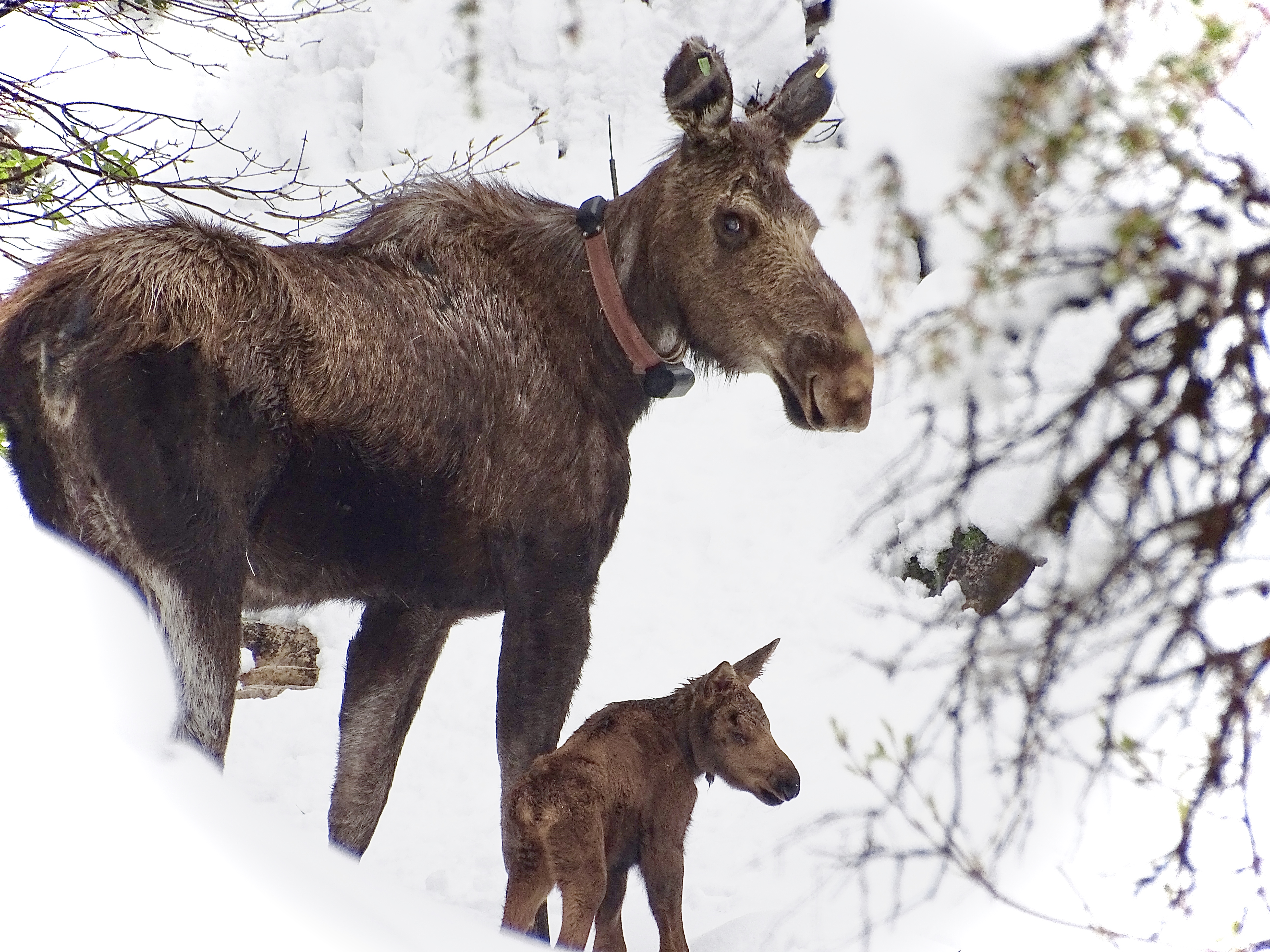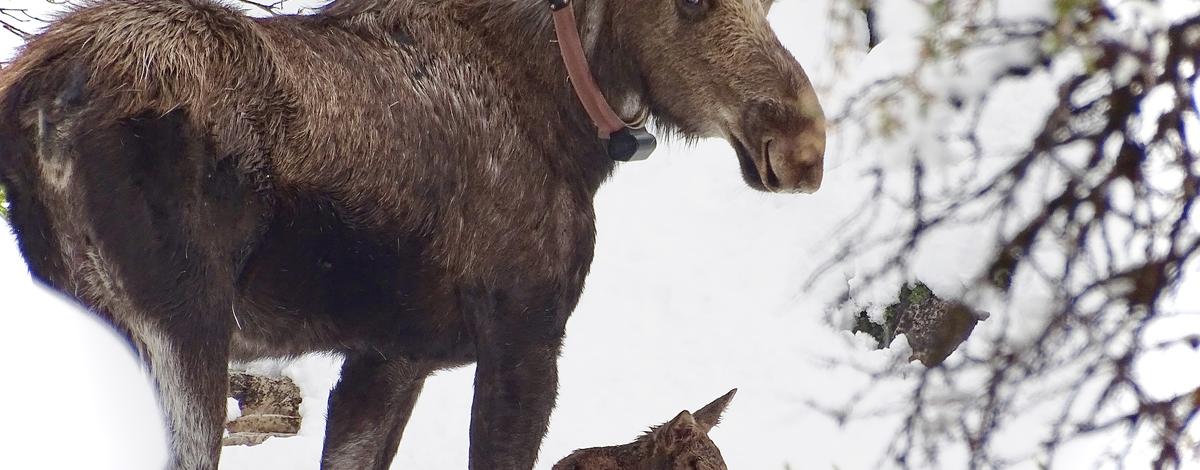Idaho Fish and Game and University of Idaho researchers began a multi-year moose research project in early 2020. Adult survival so far has been better than expected, but populations are still declining in the long term. They hope more research will provide clues on how to help Idaho’s largest big game animal rebound, or at least, discover what’s causing their decline in Idaho and beyond.

After attaching tracking collars to 112 moose in 2020, researchers are learning how many are surviving, dying, and what’s killing them, but they still need more answers. About 89 percent of the 112 adult cow moose with tracking collars survived through fall, and biologists also tested them to detect diseases, parasites and other things that could affect their survival and health.
According to Fish and Game’s wildlife research manager Mark Hurley, the survival rate of adult cow moose was higher than expected.
“It really was a pleasant surprise,” Hurley said. “We expected survival to be lower than that, given that moose populations are declining throughout the southern part of their range, including in Idaho.”
Not just an Idaho problem
Moose populations have declined in parts of the U.S. since the 1990s, and concerns about the long-term health of moose populations nationally have escalated since the early 2000s.
Eastern moose populations were the first to experience significant reductions. Moose populations in the West appeared to fare better than their eastern counterparts, but the Rocky Mountain states eventually faced similar trends.
After Idaho’s moose populations peaked in the 2000s, harvest records, field staff and hunter reports indicated their numbers in many regions were stable or declining.
As a result, there have been fewer opportunities for hunters. Since 2009, statewide moose tag numbers have decreased, leading up to the 2021-22 seasons currently be considered, which could see the largest proportional decrease in tags in 30 years.
The Idaho Fish and Game Commission will finalize moose seasons during its Jan. 28 meeting in Boise. People can view the season proposals and provide comments until Dec. 30.
Low calf survival and diseases could be culprits
Biologists said an 89 percent survival rate for adult cow moose so far means adult mortality may not be the primary cause of the population decline, so researchers are also focusing on reproduction and calf survival in the coming years to try and pinpoint reasons for the decline.
“Now that we’ve got the picture of adult cow survival, which isn’t horrendous, we’ve got questions about pregnancies being carried to term and early calf survival, which we’re trying to take a deeper look at,” Hurley said.
When researchers captured cow moose to attach tracking collars, biologists determined about 85 percent of them were pregnant at the time. When researchers returned to monitor the cows shortly after they gave birth in the spring, only 70 percent of them had calves with them, and about 69 percent of the cows that were observed with calves in the spring still had them in September.
“It is possible some pregnancies aren’t being carried to term, or there is a significant cause of early calf mortality, and we will continue to look at that,” Fish and Game’s wildlife research coordinator Shane Roberts said. “While there will always be some calf mortality before we’re able to observe them the first time after birth, there is a discrepancy worth looking into further.”
“The next thing we plan to look at is calf survival, and really understand calf survival from birth through the first year,” Hurley added. “That seems to be an area of concern. It could be a multitude of things, from fetal survival to early predation. We don’t really know yet, but we are hoping to get more detailed information during spring when cows start calving again.”
Along with watching cows and monitoring calf survival up to 6 months of age, researchers will also add tracking collars to calves during winter so they can see how many survive between ages 6 months to a year old.
“That is usually when you see predation from larger predators, like wolves or mountain lions, and also when you see mortality from parasites, like winter ticks,” Hurley said. “By the end of this winter, we should be able to really focus in on the causes of mortality, and ask really good questions.”
Disease, parasites may be the biggest initial concern for adults
Another major component of the first year of the study was learning more about how adult moose died. Of the nine radio collared adult moose that died in the first eight months of the study, more than half were attributed to parasites and/or disease. Three of those were attributed to emaciation with a concurrent winter tick infestation.
Two other deaths were attributed to predation, one wolf caused and one lion or bear caused. Another moose died as the result of a vehicle collision, and one other cause of death could not be determined.
Researchers also performed necropsies — death investigations of animals — on moose that had not been collared, which revealed additional diseases and causes of mortality not represented in the sample of collared animals.
Again, emaciation – concurrent with a winter tick infestation – and parasitic disease were the leading cause of death, followed by infectious/inflammatory diseases, vehicle collisions, non-infectious diseases, neurologic diseases and predation.
“One of the most interesting things we’ve found is all the different ways moose are dying,” Roberts said “And there are a lot, many of which are driven by diseases and parasites. It can be several encompassing things, but many factors are associated with winter tick infestations, which seems to be the number-one issue so far.”
“Those are some causes of mortality we shouldn’t be seeing in any species — tick-related deaths, or deaths related to external parasites,” Hurley added. “But we are seeing them, and they are really specific to moose.”
Biological samples submitted by hunters provides more information
Researchers collected biological samples from all of the moose collared in the study, not just the ones that died, which allowed them to test for diseases and parasites among the live animals.
One-third of the samples had at least one parasite species detected, and 85 percent of a subsample tested positive for anaplasmosis, a tick-borne disease that may contribute to mortalities.
Researchers were able to test more moose after Fish and Game sent 639 biological test kits to Idaho moose hunters in 2019, who returned 71 percent of them with samples from moose they harvested. A similar proportion of moose from this group — 39 percent — had at least one parasite species detected.
Heading into the next couple years of the study, researchers will delve further into the specific parasites and diseases found in moose, and determine whether, or how much, they contribute to moose mortality.

